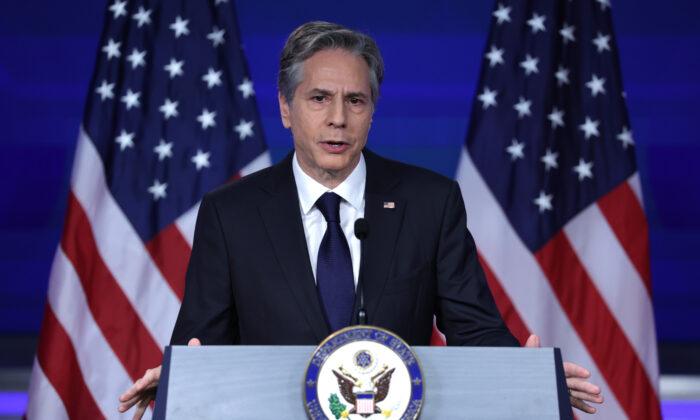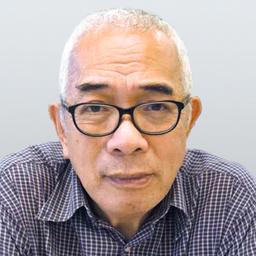The Biden administration’s highly accommodative approach will likely usher in another era of appeasement toward the Chinese Communist Party (CCP) and put the free world in harm’s way.
U.S. Secretary of State Antony Blinken delivered a lackluster China policy speech on May 26 in which he reiterated President Joe Biden’s oft-quoted policy of not seeking a new cold war with China, not seeking “unilateral changes to the status quo,” not seeking to strengthen alliances against it, and not supporting Taiwan’s independence.
To be fair, the administration is fully aware of the potential threat the CCP poses to the world. While Blinken stressed that Washington sees Beijing as a “long-term challenge” with the intention and ability to change the world order, Biden disclosed in his May 27 speech that CCP leader Xi Jinping told him that the authoritarian political system would ultimately prevail over the democratic one. Clearly, Xi believes that China will replace the United States in the long run.
Unfortunately, the administration’s awareness of the CCP’s intentions is not translated into firm actions to eliminate the threat but to accommodate it.
The three-thronged approach outlined by Blinken—“invest, align, compete”—does not confront the CCP head-on. It is but another way of expressing Biden’s “three Cs policy”—compete, cooperate, confront—which is wishful thinking. Such an approach assumes that the CCP is like-minded in its strategic thinking so that it is ready to carve out bilateral relations into three portions, fitting each to one of the Cs. It also assumes that the CCP is still willing to accept a U.S.-led world order. Such an appeasement-oriented approach will result in an aggrandizing CCP that eventually comes to plague the free world.
In the last 75 years, Sino-American history saw three major rounds of U.S. appeasement toward the CCP that eventually helped breed the communist monster of today. In the immediate post-World War II years, at the height of the Chinese civil war between the CCP and the ruling Kuomintang (KMT), the CCP succeeded in deceiving the American government that it would bring about a democratic and free China if it won. CCP founder Mao Zedong provided a written question and answer about democracy to Reuters correspondent Doon Campbell, which was published in the Xinhua Ribao on Sept. 27, 1945:
“Question: What are the concept and definition of a free and democratic China according to the Chinese Communist Party?
“A free and democratic China will be this kind of nation: all levels of government, including the central government, are created by general and equal secret balloting and are responsible to the people who elected them. It will implement Dr. Sun Yat-sen’s three principles of democracy, [Abraham] Lincoln’s principle of ‘of the people, by the people, and for the people’, and [Franklin D.] Roosevelt’s Four Freedoms as enshrined in the Atlantic Charter. It will assure the independence and unity of the nation and cooperate with all democratic powers.” (The “Four Freedoms” refer to freedom of speech, freedom of worship, freedom from want, and freedom from fear.)
This, and numerous similar proclamations, tipped the balance. The U.S. government decided to help the CCP by reining in the KMT central government, which was portrayed as corrupt by the CCP’s propaganda. President Harry Truman sent George Marshall to broker a ceasefire, which in effect tied the KMT’s hand in favor of the CCP leading, among other factors, to its final victory.
This was the first American appeasement that helped grow the CCP. The U.S. political elites felt terribly sorry for it, especially when both countries soon fought each other in the Korean War. This prompted a debate over who “lost” China, which was considered a “disaster in Asia” or an “avoidable catastrophe” by various political scientists.

The second spell of appeasement came in 1972 with the Nixon breakthrough. Aimed at containing the USSR, the realist Henry Kissinger persuaded U.S. President Richard Nixon to dump the KMT-run Taiwan in favor of the CCP-led China. (Incidentally, Kissinger’s recent advice for Ukraine to surrender territories to Russia in exchange for a ceasefire reminded one of his Machiavellian advice 50 years ago regarding Taiwan).
Washington did not block China’s entry into the United Nations and allowed it to take over the U.N. Security Council’s permanent membership from the KMT. This threw the door wide open for the CCP to widen its global space. Clearly, the United States was helping the CCP to come close to its world ambition.
The third spell came in 2000 when President Bill Clinton decided to “delink” China’s most favored nation privilege and human rights when many Chinese people were still reeling from the 1989 Tiananmen Square massacre. He also cleared the way for China’s entry into the World Trade Organization (WTO), misbelieving that a more open China would be less repressive. This reflected a serious lack of understanding of the nature of the CCP regime.
WTO membership helped propel the Chinese economy into the second-largest one in the world in a short span of two decades. During this third round of appeasement, the CCP has grown into a formidable size with the will and ability to challenge the United States—ideologically, politically, and militarily.
It is high time for the United States to learn from the consequences of its appeasement policy. President Ronald Reagan’s famous 1987 “Berlin Wall speech” that he delivered at the Brandenburg Gate in Berlin—in which he challenged the USSR to “tear down this wall”—changed the course of history, and sets an example for Biden to confront communism with resolve.





